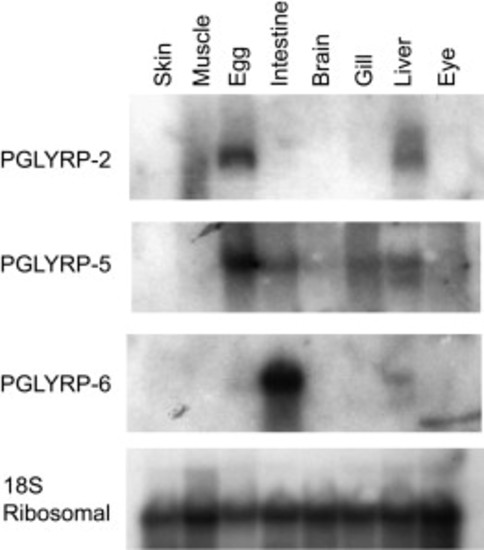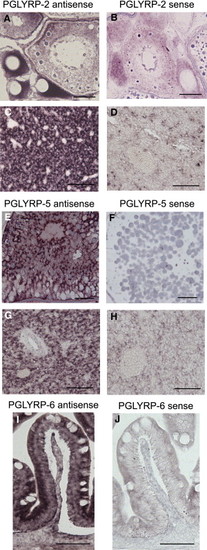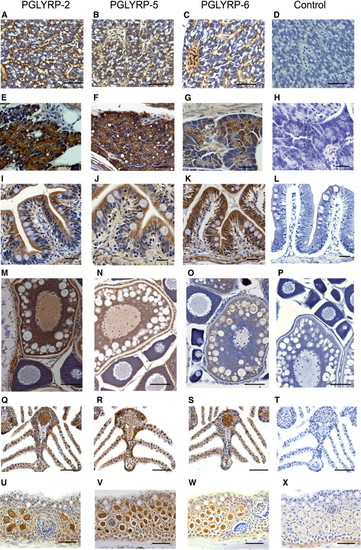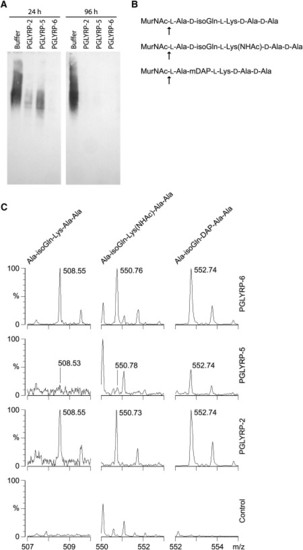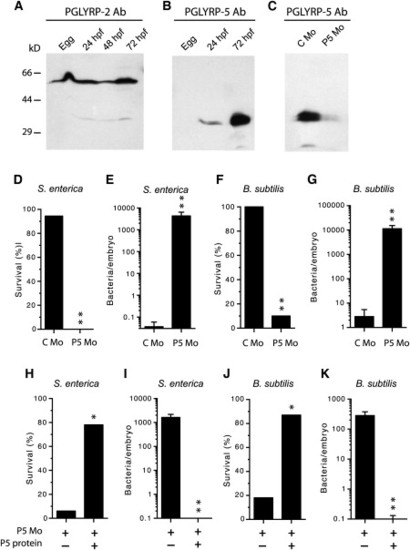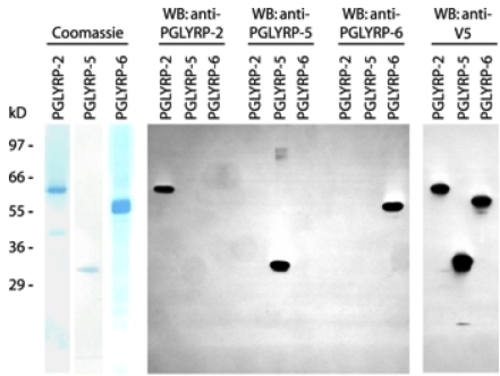- Title
-
Zebrafish Peptidoglycan Recognition Proteins Are Bactericidal Amidases Essential for Defense against Bacterial Infections
- Authors
- Li, X., Wang, S., Qi, J., Echtenkamp, S.F., Chatterjee, R., Wang, M., Boons, G.J., Dziarski, R., and Gupta, D.
- Source
- Full text @ Immunity
|
Zebrafish PGLYRP-2, PGLYRP-5, and PGLYRP-6 mRNAs Are Differentially Expressed in Various Tissues. RNA blots with RNA isolated from different adult zebrafish tissues were hybridized with the indicated probes and exposed to X-ray film. Hybridization with the 18S ribosomal probe demonstrates equal loading of the RNA samples. The results are from one of three similar experiments. |
|
PGLYRP-2, PGLYRP-5, and PGLYRP-6 Transcripts Are Differentially Expressed in Developing Oocytes, Liver, and Intestine of Adult Zebrafish. Sections of zebrafish developing oocytes (A and B) and liver (C and D) were hybridized with PGLYRP-2 antisense (A and C) or sense (B and D) RNA probes. Sections of developing oocytes (E and F) and liver (G and H) were hybridized with PGLYRP-5 antisense (E and G) or sense (F and H) probes. Sections of intestine (I and J) were hybridized with PGLYRP-6 antisense (I) or sense (J) probes. Scale bars represent 50 μm. The results are from one of three similar experiments. EXPRESSION / LABELING:
|
|
Zebrafish PGLYRP-2, PGLYRP-5, and PGLYRP-6 Proteins Are Expressed in the Liver, Pancreas, Intestine, Developing Oocytes, Gills, and Skin of Adult Zebrafish. Sections of zebrafish liver (A–D), pancreas (E–H), intestine (I–L), developing oocytes (M–P), gills (Q–T), and skin (U–X) were reacted with PGLYRP-2 (A, E, I, M, Q, and U), PGLYRP-5 (B, F, J, N, R, and V), PGLYRP-6 (C, G, K, O, S, and W), or control (D, H, L, P, T, and X) antibody, stained with peroxidase, and counterstained with hematoxylin. Scale bars for (A)–(L) represent 25 μm, and scale bars for (M)–(X) represent 50 μm. The results are from one of three similar experiments. EXPRESSION / LABELING:
|
|
Zebrafish PGLYRP Proteins Are Enzymes with N-Acetylmuramoyl-L-Alanine Amidase Activity. (A) S. aureus soluble polymeric peptidoglycan, labeled with biotin on terminal Gly, was incubated in buffer alone or with the indicated PGLYRPs for 24 or 96 hr. High-molecular-weight polymeric biotin-peptidoglycan was detected on an immunoblot with streptavidin-peroxidase. Hydrolysis of the peptide from the glycan chain removes the biotin-labeled peptide. The results are from one of two similar experiments. (B and C) The muropeptides indicated in (B) were incubated in buffer alone (control) or in the presence of the indicated PGLYRPs, and the hydrolysis products were identified with MALDI-TOF MS; peaks for the indicated peptides and observed masses ([M + Na]+) are shown in (C). The vertical scale in the left-hand PGLYRP-5 and PGLYRP-2 panels was expanded so that minor peaks are revealed. The unlabeled peaks are either matrix or buffer adduct peaks that are the same in both digested and undigested samples or reflect natural isotopic distribution of the digestion products. K+ adducts of the same peptides were also detected (not shown). The hydrolyzed bond is indicated in (B) by an arrow. Identical hydrolysis products were generated by incubation of the same substrates with human PGLYRP-2, a proven N-acetyl-muramoyl-L-alanine amidase (Wang et al., 2003), as a positive control (not shown). The results are from one of two similar experiments. |
|
PGLYRP-5 and PGLYRP-2 Are Expressed in the Developing Embryos, and PGLYRP-5 Is Essential for In Vivo Protection against Infection (A–C) Cell lysates from eggs or from embryos at the indicated developmental stage were analyzed by immunoblotting with PGLYRP-2 (A) or PGLYRP-5 (B and C) antibody. Size markers are shown on the left. The results are from one of three similar experiments. (D–K) Eggs at the two- to eight-cell stage were injected with 1 nl of 0.5 mM PGLYRP-5 morpholino (P5 Mo) or a control morpholino (C Mo). At the onset of circulation (∼30 hpf), embryos were injected with S. enterica (D and E) or B. subtilis (F and G) or with S. enterica (H and I) or B. subtilis (J and K) and PGLYRP-5 protein (P5 protein) or buffer. Embryos were assayed for survival at 4 hpi or lysed for determining numbers of recovered bacteria per embryo at 2–3 hpi. The data in each panel are from two to three experiments with the following total numbers of embryos with C Mo and P5 Mo or - and + P5 protein, respectively: (D), 18 and 24; (E), 35 and 43; (F), 24 and 19; (G), 24 and 21; (H), 16 and 9; (I), 16 and 12; (J), 16 and 15; (K), 20 and 28. The survival and the numbers of recovered bacteria were significantly different at p = 0.0002 (*) or p < 0.0001 (**) between PGLYRP-5 morpholino- and control morpholino-injected groups or between PGLYRP-5 protein-injected and buffer-injected groups. The bactericidal results are means ± SE from two to three experiments. EXPRESSION / LABELING:
PHENOTYPE:
|
|
Zebrafish PGLYRP Proteins, Purity, and Reactivity with Antibodies PGLYRP proteins were purified from supernatants of stable S2 cell transfectants and analyzed by Coomassie blue staining (5 μg/lane) or Western blots (WB, 0.5 μg/lane). Proteins were detected on Western blots using anti-PGLYRP-2, anti-PGLYRP-5, anti-PGLYRP-6, or anti-V5 antibody. Size markers are shown on the left. |

Unillustrated author statements EXPRESSION / LABELING:
|
Reprinted from Immunity, 27(3), Li, X., Wang, S., Qi, J., Echtenkamp, S.F., Chatterjee, R., Wang, M., Boons, G.J., Dziarski, R., and Gupta, D., Zebrafish Peptidoglycan Recognition Proteins Are Bactericidal Amidases Essential for Defense against Bacterial Infections, 518-29, Copyright (2007) with permission from Elsevier. Full text @ Immunity

